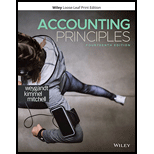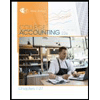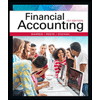
ACCT.PRINCIPLES (LL)
14th Edition
ISBN: 9781119707110
Author: Weygandt
Publisher: WILEY
expand_more
expand_more
format_list_bulleted
Concept explainers
Question
Chapter 4, Problem 11E
a.
To determine
Introduction: At the end of an accounting year, the revenue, expenses, and owners’ drawing account are closed by a company by transferring their balance to the owners’ capital accounts. This process of closing the accounts is made by preparing the closing entries.
To prepare: The closing entries that were made on June 30.
b.
To determine
Introduction: At the end of an accounting year, the revenue, expenses, and owners’ drawing account are closed by a company by transferring their balance to the owners’ capital accounts. This process of closing the accounts is made by preparing the closing entries.
To
Expert Solution & Answer
Want to see the full answer?
Check out a sample textbook solution
Students have asked these similar questions
Hello tutor please given General accounting question answer do fast and properly explain all answer
Chalmers Corporation operates in multiple areas of the globe, and relatively large price changes are common. Presently, the company sells 110,200 units for $50 per unit. The variable production costs are $20, and fixed costs amount to $2,079,500. Production engineers have advised management that they expect unit labor costs to rise by 10 percent and unit materials costs to rise by 15 percent in the coming year. Of the $20 variable costs, 25 percent are from labor and 50 percent are from materials. Variable overhead costs are expected to increase by 20 percent. Sales prices cannot increase more than 12 percent. It is also expected that fixed costs will rise by 10 percent as a result of increased taxes and other miscellaneous fixed charges.
The company wishes to maintain the same level of profit in real dollar terms. It is expected that to accomplish this objective, profits must increase by 8 percent during the year.
Required:
Compute the volume in units and the dollar sales level…
After describing a threat/risk in either the revenue cycle (i.e., in sales and cash collection activities) or the expenditure cycle (i.e., in purchases or cash disbursement activities).
What are specific internal controls that might be applied to mitigate each of the threats we've identified?
Chapter 4 Solutions
ACCT.PRINCIPLES (LL)
Ch. 4 - Prob. 1QCh. 4 - 2. Explain the purpose of the worksheet.
Ch. 4 - 3. What is the relationship, if any, between the...Ch. 4 - Prob. 4QCh. 4 - Prob. 5QCh. 4 - Prob. 6QCh. 4 - Prob. 7QCh. 4 - Prob. 8QCh. 4 - 9. Which of the following accounts would not...Ch. 4 - 10. Distinguish between a reversing entry and an...
Ch. 4 - Prob. 11QCh. 4 - Prob. 12QCh. 4 - Prob. 13QCh. 4 - Prob. 14QCh. 4 - Prob. 15QCh. 4 - Prob. 16QCh. 4 - Prob. 17QCh. 4 - Prob. 18QCh. 4 - Prob. 20QCh. 4 - Prob. 21QCh. 4 - BE4-1 The steps in using a worksheet are presented...Ch. 4 - Prob. 2BECh. 4 - Prob. 3BECh. 4 - Prob. 4BECh. 4 - Prob. 5BECh. 4 - Prob. 6BECh. 4 - Prob. 7BECh. 4 - BE4-8 The steps in the accounting cycle are listed...Ch. 4 - Prob. 9BECh. 4 - Prob. 10BECh. 4 - Prob. 11BECh. 4 - Prob. 12BECh. 4 - Prob. 1DIECh. 4 - Prob. 2DIECh. 4 - DO IT! 4-3 Hanson Company has an inexperienced...Ch. 4 - Prob. 4DIECh. 4 - Prob. 1ECh. 4 - E4-2 The adjusted trial balance columns of the...Ch. 4 - E4-3 Worksheet data for Savaglia Company are...Ch. 4 - E4-4 Worksheet data for Savaglia Company are...Ch. 4 - Prob. 5ECh. 4 - Prob. 6ECh. 4 - Prob. 7ECh. 4 - Prob. 8ECh. 4 - Prob. 9ECh. 4 - E4-10 Renee Davis has prepared the following list...Ch. 4 - Prob. 11ECh. 4 - Prob. 12ECh. 4 - Prob. 13ECh. 4 - Prob. 14ECh. 4 - Prob. 15ECh. 4 - Prob. 16ECh. 4 - Prob. 17ECh. 4 - Prob. 18ECh. 4 - Prob. 19ECh. 4 - P4-1A The trial balance columns of the worksheet...Ch. 4 - P4-3A The completed financial statement columns of...Ch. 4 - P4-5A Anya Clark opened Anya’s Cleaning Service on...Ch. 4 - Prob. 7EYCTCh. 4 - Prob. 1ISTQCh. 4 - Prob. 2ISTQCh. 4 - Prob. 3ISTQCh. 4 - Prob. 4ISTQCh. 4 - Prob. 1IFRECh. 4 - Prob. 2IFRECh. 4 - Prob. 3IFRECh. 4 - Prob. 4IFRE
Knowledge Booster
Learn more about
Need a deep-dive on the concept behind this application? Look no further. Learn more about this topic, accounting and related others by exploring similar questions and additional content below.Similar questions
- Compare and contrast the procedures for lodging an objection in Jamaica with those of Trinidad and Tobago.arrow_forwardThe actual cost of direct labor per hour is $16.25 and the standard cost of direct labor per hour is $15.00. The direct labor hours allowed per finished unit is 0.60 hours. During the current period, 4,500 units of finished goods were produced using 2,900 direct labor hours. How much is the direct labor rate variance? A. $3,625 favorable B. $3,625 unfavorable C. $4,350 favorable D. $4,350 unfavorablearrow_forwardOn January 1 of the current year, Piper Company issues a 4-year, non-interest-bearing note with a face value of $8,000 and receives $4,952 in exchange. The recording of the issuance of the note includes a: a. credit to Notes Payable for $4,952. b. credit to Discount on Notes Payable for $3,048. c. debit to Discount on Notes Payable for $3,048. d. debit to Cash for $8,000.arrow_forward
- During September, the assembly department completed 10,500 units of a product that had a standard materials cost of 3.0 square feet per unit at $2.40 per square foot. The actual materials purchased consisted of 22,000 square feet at $2.60 per square foot, for a total cost of $57,200. The actual material used during this period was 25,500 square feet. Compute the materials price variance and materials usage variance.arrow_forwardBluesy Electronics recorded the following financial data: Net Sales $720,500 Average Inventory at Cost = $80,200 Gross Margin Percentage = 42% Calculate the GMROI.arrow_forwardNeed help this question solutionarrow_forward
arrow_back_ios
SEE MORE QUESTIONS
arrow_forward_ios
Recommended textbooks for you
 College Accounting, Chapters 1-27 (New in Account...AccountingISBN:9781305666160Author:James A. Heintz, Robert W. ParryPublisher:Cengage Learning
College Accounting, Chapters 1-27 (New in Account...AccountingISBN:9781305666160Author:James A. Heintz, Robert W. ParryPublisher:Cengage Learning College Accounting, Chapters 1-27AccountingISBN:9781337794756Author:HEINTZ, James A.Publisher:Cengage Learning,
College Accounting, Chapters 1-27AccountingISBN:9781337794756Author:HEINTZ, James A.Publisher:Cengage Learning, Financial AccountingAccountingISBN:9781337272124Author:Carl Warren, James M. Reeve, Jonathan DuchacPublisher:Cengage Learning
Financial AccountingAccountingISBN:9781337272124Author:Carl Warren, James M. Reeve, Jonathan DuchacPublisher:Cengage Learning- Principles of Accounting Volume 1AccountingISBN:9781947172685Author:OpenStaxPublisher:OpenStax CollegeCentury 21 Accounting Multicolumn JournalAccountingISBN:9781337679503Author:GilbertsonPublisher:Cengage
 Financial Accounting: The Impact on Decision Make...AccountingISBN:9781305654174Author:Gary A. Porter, Curtis L. NortonPublisher:Cengage Learning
Financial Accounting: The Impact on Decision Make...AccountingISBN:9781305654174Author:Gary A. Porter, Curtis L. NortonPublisher:Cengage Learning

College Accounting, Chapters 1-27 (New in Account...
Accounting
ISBN:9781305666160
Author:James A. Heintz, Robert W. Parry
Publisher:Cengage Learning

College Accounting, Chapters 1-27
Accounting
ISBN:9781337794756
Author:HEINTZ, James A.
Publisher:Cengage Learning,

Financial Accounting
Accounting
ISBN:9781337272124
Author:Carl Warren, James M. Reeve, Jonathan Duchac
Publisher:Cengage Learning

Principles of Accounting Volume 1
Accounting
ISBN:9781947172685
Author:OpenStax
Publisher:OpenStax College

Century 21 Accounting Multicolumn Journal
Accounting
ISBN:9781337679503
Author:Gilbertson
Publisher:Cengage

Financial Accounting: The Impact on Decision Make...
Accounting
ISBN:9781305654174
Author:Gary A. Porter, Curtis L. Norton
Publisher:Cengage Learning
The accounting cycle; Author: Alanis Business academy;https://www.youtube.com/watch?v=XTspj8CtzPk;License: Standard YouTube License, CC-BY